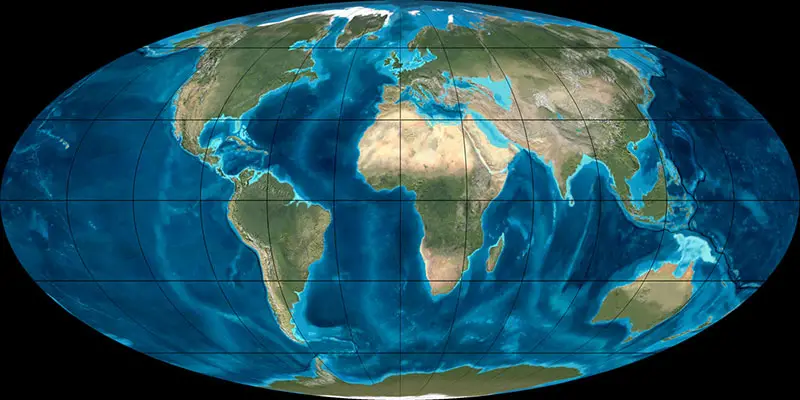†Soriacebus (Homunculidae)
Soriacebus ist eine Primatengattung innerhalb der Familie Homunculidae, deren 3 Mitglieder ab dem frühen Neogen (Miozän) im Burdigalium lebten, das vor ungefähr 20,4 Millionen Jahren begann und bis vor 16 Millionen Jahren andauerte. Viele Überreste wurden in Argentinien gefunden.
Soriacebus aus der Ordnung Platyrhini ist eine ausgestorbene Primatengattung der Neuen Welt.
Die Funde aus dem Süden Argentiniens sind rund 20 Millionen Jahre alt. Es werden 2 Arten unterschieden.
Soriacebus adrianae
| Sammlung | Epoche, Alter | Geologie, Formation |
|---|---|---|
| Portezuelo Sumich Sur, Pinturas Fm., Lago Buenos Aires, Santa Cruz | Pinturas | |
| Kommentar z. Stratigraphie | Museum | |
| Pertains to "Middle Sequence" = "Pinturan" of Kramarz & Bellosi 2005 | MACN |
| Physiologie | |
|---|---|
| Gewicht: | ? |
| Schwestertaxa | |
Soriacebus ameghinorum
| Sammlung | Epoche, Alter | Geologie, Formation |
|---|---|---|
| Portezuelo Sumich Norte, Pinturas Fm., Lago Buenos Aires | Pinturas | |
| Kommentar z. Stratigraphie | Lithographie | Museum |
| Pertains to "Middle Sequence" = "Pinturan" of Kramarz & Bellosi 2005 Brandoni et al 2016: The absolute ages of ca. 17.99 Ma near the base of the Pinturas Formation at Estancia el Carmen (47? 120 44.6400S, 70? 340 9700W), and ca. 16.8 Ma in the Santa Cruz For- mation that overlies the Pinturas Formation at Portezuelo Sumich Norte (see Perkins et al. 2012 and Fleagle et al. 2012) (Fig. 1b) indicate that the lower and middle sequences from the Pinturas Formation would be similar in age to those from the coastal localities of the Santa Cruz Formation (‘‘typical Santacrucian fauna’’) with ages of ca. 18–16 Ma (Bown and Fleagle 1993; Fleagle et al. 1995; Tejedor et al. 2006; Perkins et al. 2012), and younger than those from the lower Fossil Zone of the Colhue-Huapi Member of the Sarmiento Formation (‘‘Colhuehuapian fauna’’) (Kramarz et al. 2010) with ages of ca. 20.4–20.0 Ma (Re´ et al. 2010) or 21.11–18.62 Ma (Dunn et al. 2013) (Fig. 2) Brandoni et al 2016: In the locality of Portezuelo Sumich Norte (46? 570 33.0900S, 70? 400 200W; Fig. 1a, b), numerous fossil remains (including primates) come from opposite sides of a badland ridge that probably preserves a part of the base of the middle sequence that has filled a scour cur into the top of the lower sequence (Bown and Larriestra 1990 fig. 9a; T. Bown, Pers. Com). There is an absolute age of ca. 16.8 Ma from a tuff of the Santa Cruz Formation that lies uncon- formably over the top of the Pinturas sequence (Bown and Larriestra 1990; Perkins et al. 2012; Fleagle et al. 2012); | Brandoni et al 2016: The Pinturas Formation is composed of up to 100 m of Miocene continental pyroclastic and eolian epiclastic sed-iments outcropping in the upper valley of the Pinturas River and its tributaries (Fig. 1a). It lies unconformably atop the Jurassic La Matilde Formation (Bahı´a Laura River and its tributaries (Fig. 1a). It lies unconformably atop the Jurassic La Matilde Formation (Bahı´a Laura Group), and is divided by two intraformational erosional unconformities into three sequences: (a) the lower sequence, dominated by pyroclastic mudrocks upon which very mature paleosols were formed; (b) the middle sequence, composed largely by epiclastic sand occurring as barchanoid paleodunes; and (c) the upper sequence, con-sisting of massive, poorly bedded pyroclastic mudrocks (Bown et al. 1988; Bown and Larriestra 1990). The Pin-turas Formation differs from the Santa Cruz Formation in the greater volume of pyroclastic materials, absence of marine intercalations, and the presence of mature paleosols in the lower sequence (Bown and Larriestra 1990). | MACN |
Literatur
J. G. Fleagle, D. W. Powers, G. C. Conroy, J. P. Watters 1987, New Fossil Platyrrhines from Santa Cruz Province, Argentina. Folia Primatologica. 48:1-2, p. 65 - 77, DOI: 10.1159/000156286J. G. Fleagle, D. W. Powers, G. C. Conroy, J. P. Watters 1990, New fossil platyrrhines from the Pinturas Formation, southern Argentina. Journal of Human Evolution. 19:1-2, p. 61 - 85, DOI: 10.1016/0047-2484(90)90012-Z,
M. F. Tejedor, D. W. Powers, G. C. Conroy, J. P. Watters 2005, New Fossil Platyrrhine from Argentina. Folia Primatologica. 76:1-2, p. 146 - 150, DOI: 10.1159/000084377
N. M. Novo, J. G. Fleagle, G. C. Conroy, J. P. Watters 2015, New specimens of platyrrhine primates from Patagonia (Pinturas Formation, Early Miocene). Ameghiniana. 52:3, p. 367 - 372, DOI: 10.5710/AMGH.22.01.2015.2887
N. M. Novo, M. F. Tejedor, L. R. González-Ruiz, J. G. Fleagle, D. Brandoni, M. Krause 2021, Primate diversity in the early Miocene Pinturas Formation, southern Patagonia, Argentina. Anais da Academia Brasileira de Ciências. 93:2, p. e20201218 - 372, DOI: 10.1590/0001-3765202120201218
